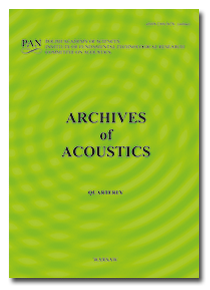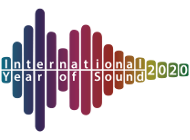10.24425/aoa.2019.126348
Perceptual Identification of Polish Vowels Due to F0 Changes
References
Assamann P.F., Nearey T.M. (2008), Identyfication of frequency schifted vowels, The Journal of the Acoustical Society of America, 124, 5, 3203–3212.
Boersma P., Weenink D. (2013), PRAAT: doing phonetics by computer [Computer program]. Version 5.3.59, retrieved December 11, 2014 from http://www.praat.org.
Carlson R., Fant G., Granström B. (1975), Two-formant models, pitch, and vowel perception, [In:] G. Fant, M.A.A. Tatham (Eds.), Auditory Analysis and Perception of Speech, Academic Press, London, pp. 55–82.
Chistovich L.A., Sheikin R.L., Lublinskaya V.V. (1979), "Centers of gravity" and spectral peaks as the determinants of vowel quality, [In:] B. Lindblom, S. Öhman (Eds.), Frontiers of Speech Communication Research, Academic Press, London, pp. 143–157.
Chladkova K., Boersma P., Podlipsky V.J. (2009), On-line formant shifting as a function of F0, Proceedings of the INTERSPEECH 2009 Conference, pp. 464–467, Brighton, UK.
Di Benedetto M.G. (1994), Acoustic and perceptual evidence of a complex relation between F1 and F0 in determining vowel height, Journal of Phonetics, 22, 205–224.
Diehl R.L., Lindblom B., Hoemeke K.A., Fahey R.P. (1996), On explaining certain male-female differences in the phonetic realization of vowel categories, Journal of Phonetics, 24, 187–208.
Długosz-Kurczabowa K., Dubisz S. (2006), Historical grammar of Polish language [in Polish: Gramatyka historyczna języka polskiego], Wydawnictwo Uniwersytetu Warszawskiego, Warszawa, pp. 96, 129.
Fant G. (1960), Acoustic theory of speech production, Mouton, Hague.
Hirahara T., Kato H. (1992), The effect of F0 on vowel identification, [In:] Speech Perception, Production and Linguistic Structure, Y. Tohkura, E. Vatikiotis-Bateson, Y. Sagisaka (Eds.), Ohmsha, Tokyo, pp. 89–112.
Imiołczyk J. (1991), Determination of perceptual boundaries between the male female and child's voices in isolated synthetic polish vowels, Archives of Acoustics, 16, 2, 305–323.
Jassem W. (1992), Acoustic-phonetic variability of polish vowels, Archives of Acoustics, 17, 2, 217–233.
Johnson K. (1988a), F0 normalization and adjusting to talker, Research on Speech Perception, Progress Report 14, pp. 237–258.
Johnson K. (1988b), Intonational context and F0 normalization, Research on Speech Perception, Progress Report 14, pp. 81–108.
Jorasz U. (1999), Selectivity of the auditory system, Adam Mickiewicz University Press, Poznań, pp. 38–51.
Klatt D.H., Klatt L.C. (1990), Analysis, synthesis, and perception of voice quality variations among female and male talkers, Journal of the Acoustical Society of America, 87, 2, 820–857.
Klatt D.H. (1980), Software for a cascade/parallel formant synthesizer, Journal of the Acoustical Society of America, 67, 971–995.
Kortekaas R.W.L., Kohlrausch A. (1997), Psychoacoustical evaluation of the pitch-synchronous overlapand-add speech-waveform manipulation technique using single-formant stimuli, Journal of the Acoustical Society of America, 101, 4, 2202–2213.
Maurer D., Suter H., Friedrichs D., Dellwo V. (2015), Gender and age differences in vowel-related formant patterns: What happens if men, women, and children produce vowels on different and on similar F0?, Journal of the Acoustical Society of America, 137, 4, 2416–2416.
Meister E., Werner S. (2009), Vowel Category Perception Affected by Microdurational Variations, Proceedings of the INTERSPEECH 2009 conference, pp. 388–391, Brighton, UK.
Mousa A. (2010), Voice conversion using pitch shifting algorithm by time stretching with PSOLA and re-sampling, Journal of Electrical Engineering, 61, 1, 57–61.
Obrębowski A. (2008), Vocal organ and its importance in social communication [in Polish: Narząd głosu i jego znaczenie w komunikacji społecznej], Wydawnictwo Naukowe Uniwersytetu Medycznego w Poznaniu.
Owsianny M. (1994), The synthesis of female voices using a software synthesizer, Archives of Acoustics, 19, 2, 185–199.
Owsianny M. (1995), The Effect of Voice Pitch on the Perception of Synthetic Polish Vowels, Proceedings of the 4th European Conference on Speech Communication and Technology – EUROSPEECH'95, pp. 945–948, Madrid, Spain.
Owsianny M. (2001), Interaction between vocalic quality and fundamental frequency in the perception of Polish vowels, Proceedings of the PROSODY 2000 Conference, Speech Recognition and Synthesis, pp. 197–204, Kraków, Poland.
Peirce J.W. (2007), PsychoPy – Psychophysics software in Python, Journal of Neuroscience Methods, 162, 1–2, 8–13.
Peterson G.E., Barney H.L. (1952), Control methods used in a study of the vowels, Journal of the Acoustical Society of America, 24, 175–184.
Sundberg J. (1977), The Acoustics of the Singing Voice, Scientific American, 236, 3, 82–4, 86, 88–91.
Syrdal A.K. (1985), Aspects of a model of the auditory representation of American English vowels, Speech Communication, 4, 121–135.
Traunmüller H. (1981), Perceptual dimension of openness in vowels, Journal of the Acoustical Society of America, 69, 5, 1465–1475.
DOI: 10.24425/aoa.2019.126348






